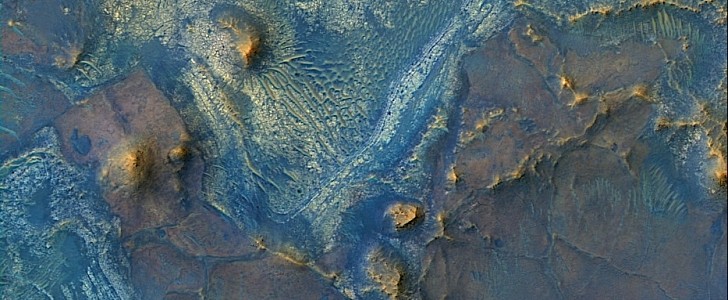For ages, when people are thinking about Mars, the first and probably only color that comes to mind is red. That’s, of course, somewhat inaccurate, but it happens nonetheless.
The target of humanity’s mid-future exploration plans, Mars gets its reddish color thanks to the layers upon layers of dust covering its surface. The dust is not actually red, but more of a rusty orange, because of the iron that makes up most of the substance, blown all over the surface eons ago and transformed this way by the oxygen that was once abundant around the planet.
From time to time, we get to see specs of white, given by the ice that can be found here and there. But one almost never gets to see other colors on the surface, except, perhaps, at the landing site for the Chinese Tianwen-1 mission, from where we were treated with some shades of blue not long ago.
But there’s a little place on Mars, on the rim of the Isidis impact basin, where one can be treated to shades of blue, green, and even yellow. All you need for that to happen is the High-Resolution Imaging Science Experiment camera (HiRISE) fitted on the Mars Reconnaissance Orbiter (MRO) high up in Martian orbit.
The image you’re looking at was taken by HiRISE back in 2016 and republished this month by the people running the MRO. It shows the Nili Fossae region, and it definitely looks more like some abstract painting than an image from the planet we all know.
The scientists running the round-the-clock observation of the planet explain these colors by saying the reddish dust we talked about above is not as present here, and what we’re looking at is the exposed bedrock. The rocks that make it up have different compositions, which when viewed through the HiRISE infrared produce different colors.
So, not exactly something one could see with the naked eye, but stunning nonetheless.
From time to time, we get to see specs of white, given by the ice that can be found here and there. But one almost never gets to see other colors on the surface, except, perhaps, at the landing site for the Chinese Tianwen-1 mission, from where we were treated with some shades of blue not long ago.
But there’s a little place on Mars, on the rim of the Isidis impact basin, where one can be treated to shades of blue, green, and even yellow. All you need for that to happen is the High-Resolution Imaging Science Experiment camera (HiRISE) fitted on the Mars Reconnaissance Orbiter (MRO) high up in Martian orbit.
The image you’re looking at was taken by HiRISE back in 2016 and republished this month by the people running the MRO. It shows the Nili Fossae region, and it definitely looks more like some abstract painting than an image from the planet we all know.
The scientists running the round-the-clock observation of the planet explain these colors by saying the reddish dust we talked about above is not as present here, and what we’re looking at is the exposed bedrock. The rocks that make it up have different compositions, which when viewed through the HiRISE infrared produce different colors.
So, not exactly something one could see with the naked eye, but stunning nonetheless.


